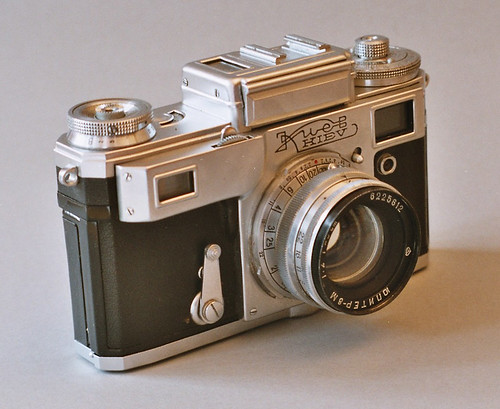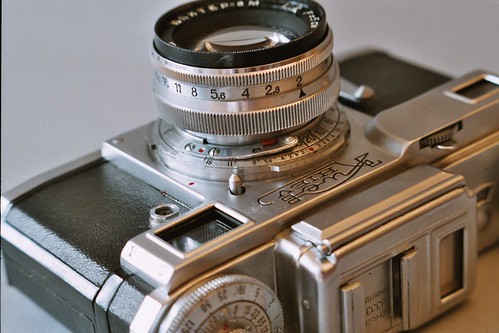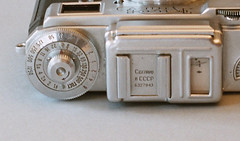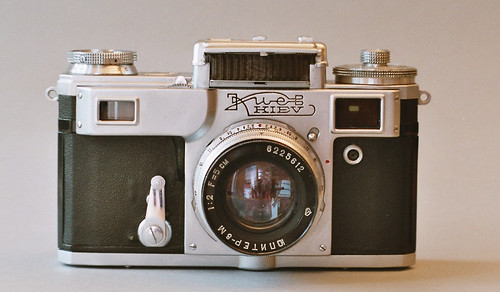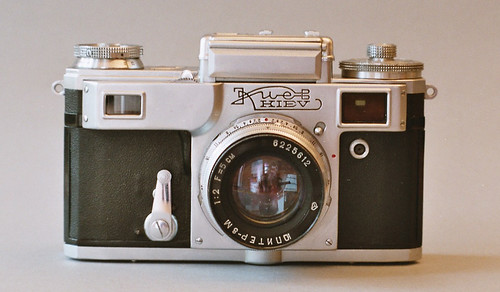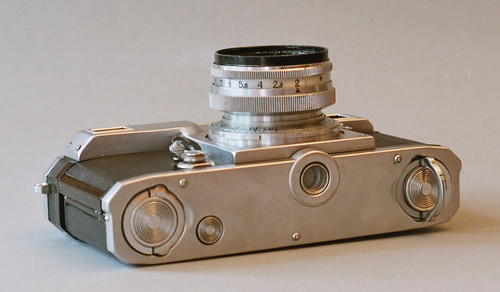Kiev 4
The Kiev 4 type 1 rangefinder.
The Kiev rangefinders were developed after WW II in the Arsenal factory in Kiev. Soviet forces had "relocated" equipment and personnel from the Zeiss Ikon factories in Germany. In Kiev Zeiss Ikon's Contax line of production was set up again and quickly started production under the Kiev brand name. Early models are said to have been made from original Zeiss Ikon stock the Soviets had taken with them. There are reports of models with the original Contax nameplate behind the new Kiev shield.
One of the excellent things about this Kiev is its long rangefinder base: 9 cm. This allows for very accurate focusing. For example, when you are focusing for a tightly composed portrait, you see a clear difference when the nose or the eyes are in perfect focus. Combined with the clear depth-of-field scale on the lens, this allows isolation of the subject from the background. Furthermore, the viewfinder and rangefinder are combined in one large bright window so you do not have to look through two windows for focusing and framing. Leica did not combine the two until the Leica M3 in 1954.
Contax Bayonet mount
In many ways the Kiev is a reliable Contax clone and a sturdy piece of metal equipment. The bayonet for the lenses is the Contax rangefinder mount, so Carl Zeiss made Contax lenses can be used. This particular lens is a Jupiter-8m standard 50/2 lens.
It was made at the Arsenal plant and the serial number, starting "62", seems to suggest it was produced in 1962. The lens has an engraved distance scale and two diaphragm scales, one visible from the top and the other only seen from the bottom of the lens. This is because the lens rotates during focusing. There are two diaphragm scales so that there is always one at least partially visible from above. In some focusing positions, the two scales are to the left and to the right. It was not the case in the Sonnar of the Contax II. There is only one scale, and it needs to turn the camera upside down to set the aperture at some focusing positions.
Exposure meter
The light meter on top of the camera is of the selenium cell type. By turning the ring on the left, the needle in the window is matched to the diamond. For a 2 times or 4 times overexposure, the meter has the marks -2 and -4 to extend its usability. A speed and aperture combination can then be read from the two metal rings. Of course this meter is not coupled to lens, so you'll have to set these parameters by hand. Most selenium cell meters are dead or inaccurate now since they do not age very well. Note the sensitivity range on this camera is set in gost, the Soviet equivalent of ISO/ASA. Note the coldshoe proudly states : "sdelano b SSSR"; made in the USSR. This means they were considered to be of export quality. The serial number 6327943 indicates this particular camera was made in 1963
| Kiev 4 summary |
|---|
|
Maker: Arsenal, Kiev Dates: 1950s Variants: Contax I, II, III, Kiev, Kiev 2, Kiev 3, Kiev 4a, Kiev 4am see: Kiev rangefinder Camera Type: 35mm rangefinder system Focusing: manual Rangefinder: rangefinder with a 9 cm base Lens mount: Contax mount Shutter: vertical blade shutter Exposure meter: selenium cell ASA/ISO range: 8-500 gost (i. e. 8-500 asa) Shoe: coldshoe Synchronized: {{{sync}}} X sync speed: {{{sync speed}}} TTL Flash: None Motor drive: None Battery: None |
